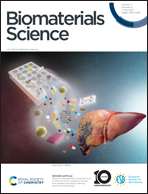Organic disulfide-modified folate carbon dots for tumor-targeted synergistic chemodynamic/photodynamic therapy†
Abstract
Carbon dots (CDs) have great potential for cancer diagnosis and treatment. Photodynamic therapy and chemodynamic therapy are promising treatments mediated by reactive oxygen species (ROS), which have the advantages of being minimally invasive, having no multi-drug resistance, and having no systemic toxic side effects. However, the tumor microenvironment (TME) and poor targetability often reduce the therapeutic effect. In this work, we have successfully prepared folate-based carbon dots (FCP-CDs) from folic acid (FA), citric acid (CA), and polyethyleneimine (PEI) for tumor-targeting. The surface of FCP-CDs was modified using organic disulfide, 3,3′-dithiodipropionic acid (DTPA), and a photosensitizer (PS) pyropheophorbide-a (PPa) to form a tumor microenvironment-responsive nanoplatform, FCP-CDs@DTPA@PPa (named FCPPD), for synergistic cancer therapy. The results showed that FCPPD effectively preserved the tumor target specificity of folic acid and the photodynamic therapeutic (PDT) activity of PPa, and could provide additional chemodynamic therapeutic (CDT) function by reacting with hydrogen peroxide (H2O2) to generate ˙OH. The introduction of DTPA, which contains disulfide bonds, endows FCPPD with an excellent ability to deplete glutathione (GSH) in tumors via intracellular redox reactions, amplifying intracellular oxidative strain and enhancing ROS-based therapeutic effects. Systematic in vitro and in vivo studies under various conditions have shown that the obtained FCPPD nanoparticles have good biocompatibility and could be a promising therapeutic agent for imaging-guided PDT/CDT combination therapy.



 Please wait while we load your content...
Please wait while we load your content...